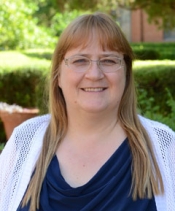ASU Regents Professor inducted into 2024 class of AIMBE College of Fellows

Petra Fromme, director of the Biodesign Center for Applied Structural Discovery, has just been inducted into the the American Institute for Medical and Biomedical Engineering (AIMBE) College of Fellows. Photo courtesy Shutterstock
The American Institute for Medical and Biological Engineering (AIMBE) has announced the induction of Regents Professor Petra Fromme, director of the Biodesign Center for Applied Structural Discovery at Arizona State University, to its College of Fellows.
Election to the AIMBE College of Fellows is among the highest professional distinctions accorded to medical and biological engineers, an honor reserved only for the top 2% of researchers in these fields.
"We welcome Petra's well-earned induction into AIMBE with great enthusiasm,” says Joshua LaBaer, executive director of the Biodesign Institute at ASU. “Petra’s research has produced major advances in the study of biomolecules at the tiniest scales and briefest intervals of time, helping to unlock some of nature’s most elusive secrets. Her pioneering efforts are pushing the boundaries of scientific understanding while offering new hope for treating and preventing a multitude of diseases.”
Fromme has been nominated, reviewed and elected by peers and members of the College of Fellows “for leading teams to develop groundbreaking XFEL technology for macromolecular structure determination with biomedical, bioenergy and materials science applications.”
College membership honors those who have made outstanding contributions to research, practice or education in engineering and medicine. It also acknowledges progress in new technology fields, advancements in medical and biological engineering, and innovative approaches to teaching bioengineering.
Fromme is recognized as a global authority in the fields of photosynthesis research, structural biology by X-ray crystallography, and protein nanocrystallography, employing X-ray Free Electron Lasers (XFEL). She has played a pivotal role in advancing serial femtosecond nanocrystallography — a groundbreaking technique that started a new era in structural biology by the discovery of molecular movies of biomolecules “in action” through XFEL technology.
Much of Fromme’s innovative research is focused on unraveling the intricate biochemical machinery, allowing photosynthetic organisms to harvest energy from sunlight, providing all higher life on Earth with energy and evolving the oxygen that we breathe.
Her intensive research into the structure-function dynamics of membrane proteins has deepened our understanding of this critical class of proteins. While notoriously tricky to study through conventional means, membrane proteins are vitally important for medicine as they are primary targets for most pharmaceutical drugs.
Fromme and her collaborators have captured initial molecular snapshots showcasing the operation of BlaC, a protease enzyme linked to antibiotic resistance, and Cytochrome c oxidase, which is vital for respiration.
Additionally, her research has helped unveil detailed structures of significant proteins such as Flpp3, a virulence factor crucial for the lethal effects of tularemia-causing bacteria; angiotensin II, a receptor governing blood pressure regulation; DIPP-NH2, an opiate ligand implicated in pain pathways; and other medically significant biomolecules.
Fromme is excited to continue her research, using a first-of-its-kind instrument currently under completion at ASU. The Compact X-ray Free Electron Laser is a device allowing detailed investigations into protein structure and dynamics at a fraction of the size and expense of large, conventional XFELs.
“Petra is renowned for her impacts on medicine and biology, and perhaps surprisingly also particle accelerators and lasers, where she leads the scientific effort to transfer cutting-edge X-ray science from giant facilities to lab-scale instruments here on the ASU campus,” says William Graves, director (ACD) and professor, Biodesign Beus CXFEL Lab.
A formal induction ceremony was held during the AIMBE annual event at the Renaissance Arlington Capital View Hotel in Arlington, Virginia, on March 25.
Fromme was inducted along with 162 colleagues who make up the AIMBE College of Fellows Class of 2024. While most AIMBE Fellows hail from the United States, the College of Fellows has inducted fellows representing more than 30 countries.
Mehdi Nikkhah, with the Biodesign Virginia G. Piper Center for Personalized Diagnostics and associate professor in the School of Biological and Health Systems Engineering, has also been inducted into AIMBE.
AIMBE Fellows are employed in academia, industry, clinical practice and government, and are among the most distinguished medical and biological engineers, including three Nobel Prize laureates and 22 Presidential Medal of Science or Technology and Innovation awardees. Additionally, 214 fellows have been inducted to the National Academy of Engineering, 117 to the National Academy of Medicine and 48 to the National Academy of Sciences.
More Science and technology

ASU water polo player defends the goal — and our data
Marie Rudasics is the last line of defense.Six players advance across the pool with a single objective in mind: making sure that yellow hydrogrip ball finds its way into the net. Rudasics, goalkeeper…

Diagnosing data corruption
You are in your doctor’s office for your annual physical and you notice the change. This year, your doctor no longer has your health history in five-inch stack of paperwork fastened together with…
Large-scale study reveals true impact of ASU VR lab on science education
Students at Arizona State University love the Dreamscape Learn virtual reality biology experiences, and the intense engagement it creates is leading to higher grades and more persistence for biology…


